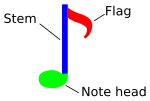Nilai not

Dalam notasi muzik, nilia not menunjukkan tempoh relatif bagi satu not, menggunakan tekstur atau bentuk kepala not, kehadiran aatau ketiadaan batang, dan kehadiran atau ketiadaan bendera/alang/cangkuk/ekor.
Tanda rehat menunjukkan a silence of an equivalent duration.
Senarai
| Not | Tanda rehat | Nama not | Nilai relatif | Nilai bertitik | Nilai dwititik | Nilai trititik |
|---|---|---|---|---|---|---|
 |  | large, duplex longa, atau maksima[1][2] (kadang kala not lapanan,[3] not penuh lapanan,[4] atau not muzik seluruh lapanan)[5] | 8 | 8 + 4 = 12 | 8 + 4 + 2 = 14 | 8 + 4 + 2 + 1 = 15 |
 |  | long[2][6][7] atau longa[8] (kadang kala not empatan[9] atau not penuh empatan)[4] | 4 | 4 + 2 = 6 | 4 + 2 + 1 = 7 | 4 + 2 + 1 + 1/2 = 7 1/2 |
 |  | brif | 2 | 2 + 1 = 3 | 2 + 1 + 1/2 = 3 1/2 | 2 + 1 + 1/2 + 1/4 = 3 3/4 |
 |  | semibref | 1 | 1 + 1/2 = 1 1/2 | 1 + 1/2 + 1/4 = 1 3/4 | 1 + 1/2 + 1/4 + 1/8 = 1 7/8 |
 |  | minim | 1/2 | 1/2 + 1/4 = 3/4 | 1/2 + 1/4 + 1/8 = 7/8 | 1/2 + 1/4 + 1/8 + 1/16 = 15/16 |
 |  atau atau  | krocet | 1/4 | 1/4 + 1/8 = 3/8 | 1/4 + 1/8 + 1/16 = 7/16 | 1/4 + 1/8 + 1/16 + 1/32 = 15/32 |
 |  | kuaver | 1/8 | 1/8 + 1/16 = 3/16 | 1/8 + 1/16 + 1/32 = 7/32 | 1/8 + 1/16 + 1/32 + 1/64 = 15/64 |
 |  | semikuaver | 1/16 | 1/16 + 1/32 = 3/32 | 1/16 + 1/32 + 1/64 = 7/64 | 1/16 + 1/32 + 1/64 + 1/128 = 15/128 |
 |  | demisemikuaver | 1/32 | 1/32 + 1/64 = 3/64 | 1/32 + 1/64 + 1/128 = 7/128 | 1/32 + 1/64 + 1/128 + 1/256 = 15/256 |
 |  | hemidemi semikuaver | 1/64 | 1/64 + 1/128 = 3/128 | 1/64 + 1/128 + 1/256 = 7/256 | 1/64 + 1/128 + 1/256 + 1/512 = 15/512 |
 |  | semihemidemisemikuaver[10][11] (jarang) | 1/128 | 1/128 + 1/256 = 3/256 | 1/128 + 1/256 + 1/512 = 7/512 | 1/128 + 1/256 + 1/512 + 1/1024 = 15/1024 |
 |  | demisemihemidemisemikuaver[4] (jarang) | 1/256 | 1/256 + 1/512 = 3/512 | 1/256 + 1/512 + 1/1024 = 7/1024 | 1/256 + 1/512 + 1/1024 + 1/2048 = 15/2048 |
Ragaman

Brif tampil dalam beberapa versi yang berbeza, seperti yang ditunjuk di kanan. Dua yang pertama biasa digunakan; yang ketiga pula pilihan bergaya.
Rujukan
- ^ William Smythe, Babcock Mathews, and Emil Liebling, "Large", Pronouncing and Defining Dictionary of Music (Cincinnati, New York, London: J. Church and Company, 1896).
- ^ a b Theodore Baker, A Dictionary of Musical Terms: Containing Upwards of 9,000 English, French, German, Italian, Latin, and Greek Words and Phrases, third edition, revised and enlarged (New York: G. Schirmer, 1897): 131.
- ^ Ray M. Owen "Glossary of Film Terms: Normal v — Noth". SoundsOfNewMexico.com, 2012. Diarkibkan 13 Ogos 2016 di Wayback Machine MC Peko, "bpm calc 2.2 // for calculating and visualizing bpm and related values // help // change-log // open source: zip js". Focus Studios, 2015.
- ^ a b c Kartik Asooja, Sindhu Kiranmai, and Paul Buitelaar "UNLP at the C@merata Task: Question Answering on Musical Scores ACM Diarkibkan 2015-11-22 di Wayback Machine"
- ^ Anonymous, "My Ambient Sounds—Sleeping Music & Ambient Soundscape Mixer to Help You Sleep Better Now Diarkibkan 2016-08-15 di Wayback Machine" (10 February 2016) Main Facts.biz (accessed 18 June 2016).
- ^ Music Dictionary (Do–Dq) Dolmetsch.com (accessed 4 February 2015).
- ^ William Smythe, Babcock Mathews, and Emil Liebling, "Double Note", Pronouncing and Defining Dictionary of Music (Cincinnati, New York, London: J. Church and Company, 1896).
- ^ John Morehen and Richard Rastall, "Note values"", The New Grove Dictionary of Music and Musicians, second edition, edited by Stanley Sadie and John Tyrrell (London: Macmillan Publishers, 2001).
- ^ John Freckleton Burrowes, Burrowes' Piano-forte Primer: Containing the Rudiments of Music Adapted for Either Private Tuition Or Teaching in Classes Together with a Guide to Practice, new edition, revised and modernized, with important additions,m by L.H. Southard (Boston and New York: Oliver Ditson, 1874): 41. Hendrik Van der Werf,.. The Oldest Extant Part Music and the Origin of Western Polyphony, 2 vols (Rochester, NY: H. van der Werf, 1993:. 1:97.
- ^ Robert J. Miller (2015). Contemporary Orchestration: A Practical Guide to Instruments, Ensembles, and Musicians. London: Routledge. m/s. 38. ISBN 978-0-415-74190-3.
- ^ David Haas (2011). "Shostakovich's Second Piano Sonata: A Composition Recital in Three Styles". Dalam Pauline Fairclough; David Fanning (eds.) (penyunting). The Cambridge Companion to Shostakovich. Cambridge Companions to Music. Cambridge and New York: Cambridge University Press. m/s. 95–114. doi:10.1017/CCOL9780521842204.006. ISBN 978-1-139-00195-3.
The listener is right to suspect a Baroque reference when a double-dotted rhythmic gesture and semihemidemisemiquaver triplets appear to ornament the theme.
CS1 maint: extra text: editors list (link)(p. 112)
Pautan luar
- How to Read Music in 30 Days - Day 1: Musical Notation & Note Values Diarkibkan 2017-10-13 di Wayback Machine
- On-line activity that counts musical notes
Templat:Notasi muzik Templat:Nilai not muzik Templat:Rhythm and meter






